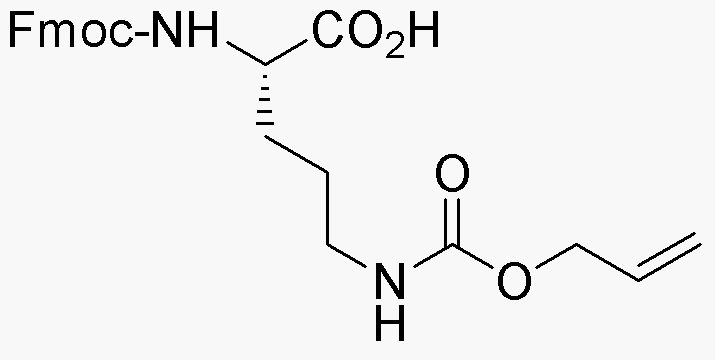Na-Fmoc-Nd-allyloxycarbonyl-L-ornithine is widely utilized in research focused on:
- Peptide Synthesis: This compound serves as a key building block in the synthesis of peptides, particularly in solid-phase peptide synthesis, allowing for the creation of complex peptide structures with high purity.
- Drug Development: Its unique functional groups make it valuable in the development of novel pharmaceuticals, especially in creating targeted therapies that require specific amino acid sequences.
- Bioconjugation: The compound is used in bioconjugation processes, enabling the attachment of biomolecules to surfaces or other molecules, which is crucial in developing biosensors and drug delivery systems.
- Research in Protein Engineering: It plays a significant role in protein engineering, aiding researchers in modifying proteins to enhance their stability and functionality, which is essential in various biotechnological applications.
- Cosmetic Formulations: The compound finds applications in cosmetic chemistry, particularly in formulations aimed at skin rejuvenation, where its properties can enhance the delivery of active ingredients.
General Information
Properties
Safety and Regulations
Applications
Na-Fmoc-Nd-allyloxycarbonyl-L-ornithine is widely utilized in research focused on:
- Peptide Synthesis: This compound serves as a key building block in the synthesis of peptides, particularly in solid-phase peptide synthesis, allowing for the creation of complex peptide structures with high purity.
- Drug Development: Its unique functional groups make it valuable in the development of novel pharmaceuticals, especially in creating targeted therapies that require specific amino acid sequences.
- Bioconjugation: The compound is used in bioconjugation processes, enabling the attachment of biomolecules to surfaces or other molecules, which is crucial in developing biosensors and drug delivery systems.
- Research in Protein Engineering: It plays a significant role in protein engineering, aiding researchers in modifying proteins to enhance their stability and functionality, which is essential in various biotechnological applications.
- Cosmetic Formulations: The compound finds applications in cosmetic chemistry, particularly in formulations aimed at skin rejuvenation, where its properties can enhance the delivery of active ingredients.
Documents
Safety Data Sheets (SDS)
The SDS provides comprehensive safety information on handling, storage, and disposal of the product.
Product Specification (PS)
The PS provides a comprehensive breakdown of the product’s properties, including chemical composition, physical state, purity, and storage requirements. It also details acceptable quality ranges and the product's intended applications.
Certificates of Analysis (COA)
Search for Certificates of Analysis (COA) by entering the products Lot Number. Lot and Batch Numbers can be found on a product’s label following the words ‘Lot’ or ‘Batch’.
*Catalog Number
*Lot Number
Certificates Of Origin (COO)
This COO confirms the country where the product was manufactured, and also details the materials and components used in it and whether it is derived from natural, synthetic, or other specific sources. This certificate may be required for customs, trade, and regulatory compliance.
*Catalog Number
*Lot Number
Safety Data Sheets (SDS)
The SDS provides comprehensive safety information on handling, storage, and disposal of the product.
DownloadProduct Specification (PS)
The PS provides a comprehensive breakdown of the product’s properties, including chemical composition, physical state, purity, and storage requirements. It also details acceptable quality ranges and the product's intended applications.
DownloadCertificates of Analysis (COA)
Search for Certificates of Analysis (COA) by entering the products Lot Number. Lot and Batch Numbers can be found on a product’s label following the words ‘Lot’ or ‘Batch’.
*Catalog Number
*Lot Number
Certificates Of Origin (COO)
This COO confirms the country where the product was manufactured, and also details the materials and components used in it and whether it is derived from natural, synthetic, or other specific sources. This certificate may be required for customs, trade, and regulatory compliance.


